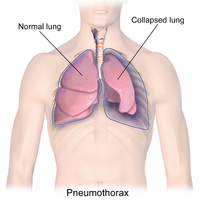
Photo from wikipedia
PURPOSE OF REVIEW The topic of perioperative hyperoxia remains controversial, with valid arguments on both the 'pro' and 'con' side. On the 'pro' side, the prevention of surgical site infections… Click to show full abstract
PURPOSE OF REVIEW The topic of perioperative hyperoxia remains controversial, with valid arguments on both the 'pro' and 'con' side. On the 'pro' side, the prevention of surgical site infections was a strong argument, leading to the recommendation of the use of hyperoxia in the guidelines of the Center for Disease Control and the WHO. On the 'con' side, the pathophysiology of hyperoxia has increasingly been acknowledged, in particular the pulmonary side effects and aggravation of ischaemia/reperfusion injuries. RECENT FINDINGS Some 'pro' articles leading to the Center for Disease Control and WHO guidelines advocating perioperative hyperoxia have been retracted, and the recommendations were downgraded from 'strong' to 'conditional'. At the same time, evidence that supports a tailored, more restrictive use of oxygen, for example, in patients with myocardial infarction or following cardiac arrest, is accumulating. SUMMARY The change in recommendation exemplifies that despite much work performed on the field of hyperoxia recently, evidence on either side of the argument remains weak. Outcome-based research is needed for reaching a definite recommendation.
Journal Title: Current Opinion in Anaesthesiology
Year Published: 2019
Link to full text (if available)
Share on Social Media: Sign Up to like & get
recommendations!